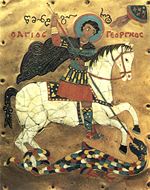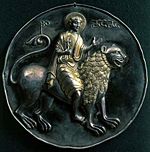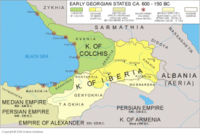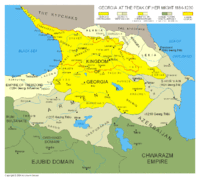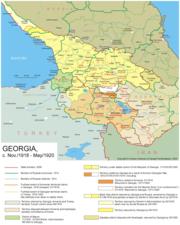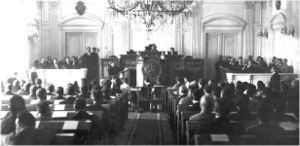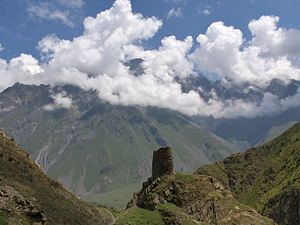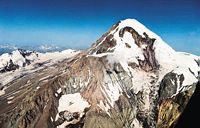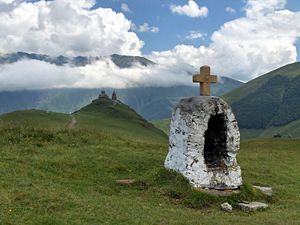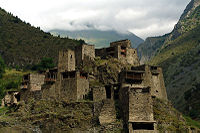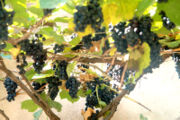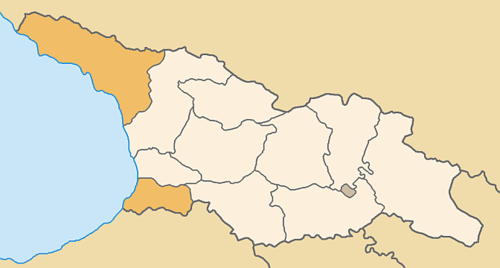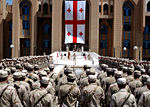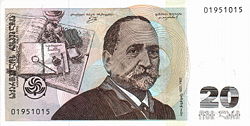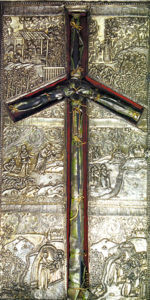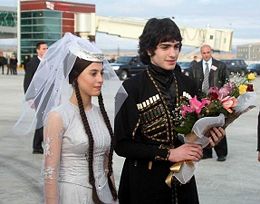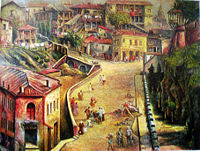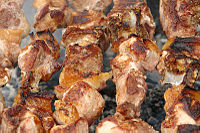Georgia (country)
From Wikipedia, the free encyclopedia
| Editing of this article by new or unregistered users is currently disabled until August 16, 2008. See the protection policy and protection log for more details. If you cannot edit this article and you wish to make a change, you can discuss changes on the talk page, request unprotection, log in, or create an account. |
| This article is related to a current event: 2008 South Ossetia war. Information may change rapidly as the event progresses. |
Georgia ([ˈdʒɔrdʒə] ; Georgian: საქართველო, Sakartvelo) is a transcontinental country partially in Eastern Europe and partially in Southwest Asia in the Caucasus region. It is bordered to the north by the Russian Federation, to the east by Azerbaijan, to the west across the Black Sea by Ukraine, to the south by Armenia and to the southwest by Turkey.[2] The territory of Georgia covers 69,700 km² and is influenced by a temperate seasonal climate. Georgia’s population is 4.4 million in the territories controlled by the central government of Georgia, nearly 84% of whom are ethnic Georgians.[3]
Two ancient Georgian states were the Kingdoms of Colchis and Iberia. The latter, one of the first countries in the world to adopt Christianity as an official religion early in the 4th century, subsequently provided a nucleus around which the unified Kingdom of Georgia was formed early in the 11th century. After a period of political, economic and cultural flourishing, this kingdom went into decline in the 13th century and eventually fragmented into several kingdoms and principalities in the 16th century. The three subsequent centuries of Ottoman and Persian hegemony were followed by a piecemeal absorption into the Russian Empire in the 19th century. After the Russian Revolution of 1917, Georgia had a brief period of independence as a Democratic Republic (1918-1921), which was terminated by the Red Army invasion of Georgia. Georgia became part of the Soviet Union in 1922 and regained its independence in 1991. Early post-Soviet years were marked by a civil unrest and economic crisis. Georgia began to gradually stabilize in 1995, and achieved more effective functioning of state institutions following a bloodless change of power in the so-called Rose Revolution of 2003.[4] However, Georgia continues to suffer from the unresolved secessionist conflicts in Abkhazia and South Ossetia. Relations with Russia remain tense over these issues as well as Georgia’s aspiration of NATO membership.[5] Currently, Georgia is engaged in armed conflict with the state of Russia.
Georgia is a representative democracy, organized as a secular, unitary, semi-presidential republic. It is currently a member of the United Nations, the Council of Europe, the Commonwealth of Independent States, the World Trade Organization, the Organization of the Black Sea Economic Cooperation, and GUAM Organization for Democracy and Economic Development. The country seeks to join NATO and, in the longer term, accession to the European Union.[6]
Contents[hide] |
Etymology and State name
Georgians call themselves Kartvelebi (ქართველები), their land Sakartvelo (საქართველო), and their language Kartuli (ქართული). According to legend, the ancestor of the Kartvelian people was Kartlos, the great grandson of the Biblical Japheth.
The native Georgian name for the country is Sakartvelo (საქართველო). The word consists of two parts. Its root, kartvel-i (ქართველ-ი), specifies an inhabitant of the core central-eastern Georgian region of Kartli – Iberia of the Classical and Byzantine sources. By the early 9th century, the meaning of "Kartli" was expanded to other areas of medieval Georgia held together by religion, culture, and language. The Georgian circumfix sa-X-o is a standard geographic construction designating "the area where X dwell", where X is an ethnonym. The term Sakartvelo came to signify the all-Georgian cultural and political unity early in the 11th century and firmly entered regular official usage in the 13th century.[7]
Ancient Greeks (Strabo, Herodotus, Plutarch, Homer, etc.) and Romans (Titus Livius, Cornelius Tacitus, etc.) referred to early eastern Georgians as Iberians (Iberoi in some Greek sources) and western Georgians (especially Mingrelians and Lazs) as Colchians.[8]
The origin of the name Georgia is still disputed and has been explained in the following ways:
1. Linking it semantically to Greek and Latin roots (respectively, γεωργος "tiller of the land" and georgicus "agricultural")[9]
2. Its derivation from the name of St. George. At least, popularity of the cult of Saint George in Georgia influenced the spread of the term.
3. Under various Persian empires (536 BC-AD 638), Georgians were called
Gurjhān (Gurzhan/Gurjan), or "Gurj/Gurzh people." The early
Islamic/Arabic sources spelled the name Kurz/Gurz and the country
Gurjistan (see Baladhuri, Tabari, Jayhani, Istakhri, Ibn Hawqal, etc.).
This also could evolve or at least contribute to the later name of
Georgia.[10]
The terms Georgia and Georgians appeared in Western Europe in numerous medieval annals including that of Crusaders and later in the official documents and letters of the Florentine de’Medici family.[11] Jacques de Vitry and English traveler, Sir John Mandeville, stated that Georgians are called Georgian because they especially revere and worship Saint George. Notably, the country recently adopted the five-cross flag, featuring the Saint George's Cross; it has been argued that the flag was used in Georgia since the 5th century.[12][13]
Modern Georgian states have used differing names in different periods. The first modern Georgian state proclaimed on 26 May 1918 adopted the name “Democratic Republic of Georgia”. As part of the USSR from 25 February 1921, the country was called the “Georgian Soviet Socialist Republic”. When Georgia broke from the USSR on 25 December 1991, it adopted the name “Republic of Georgia”. Since it adopted its present constitution on 24 August 1995, the official name of the country is simply “Georgia”.[14]
History
Prehistory
The territory of modern-day Georgia has been continuously inhabited since the early Stone Age. The classic period saw the rise of the early Georgian states of Colchis and Iberia. The proto-Georgian tribes first appear in written history in the 12th century BC.[15] Archaeological finds and references in ancient sources reveal elements of early political and state formations characterized by advanced metallurgy and goldsmith techniques that date back to the 7th century BC and beyond.[16] In the 4th century BC a unified kingdom of Georgia - an early example of advanced state organization under one king and the hierarchy of aristocracy, was established.[17]
Christianity was declared the state religion as early as AD 337 proving a great stimulus to literature, arts and the unification of the country. As a crossroad between Christian and Islamic traditions, Georgia experienced the dynamic exchange between these two worlds which culminated in a true renaissance around 12-13th centuries AD.[18]
The two early Georgian kingdoms of late antiquity, known to ancient Greeks and Romans as Iberia (Georgian: იბერია) (in the east of the country) and Colchis (Georgian: კოლხეთი) (in the west), were among the first nations in the region to adopt Christianity (in AD 337, or in AD 319 as recent research suggests).
In Greek Mythology, Colchis was the location of the Golden Fleece sought by Jason and the Argonauts in Apollonius Rhodius' epic tale Argonautica. The incorporation of the Golden Fleece into the myth may have derived from the local practice of using fleeces to sift gold dust from rivers. In the last centuries of the pre-Christian era, the area, in the form of the kingdom of Kartli-Iberia, was strongly influenced by Greece to the west and Persia to the east.[19] After the Roman Empire completed its conquest of the Caucasus region in 66 B.C., the kingdom was a Roman client state and ally for nearly 400 years.[19] In AD 330, King Marian III's acceptance of Christianity ultimately tied the kingdom to the neighboring Byzantine Empire, which exerted a strong cultural influence for several centuries.[19]
Known to its natives as Egrisi or Lazica, Colchis was often the battlefield and buffer-zone between the rival powers of Persia and Byzantine Empire, with the control of the region shifting hands back and forth several times. The early kingdoms disintegrated into various feudal regions by the early Middle Ages. This made it easy for Arabs to conquer Georgia in the 7th century. The rebellious regions were liberated and united into a unified Georgian Kingdom at the beginning of the 11th century. Starting in the 12th century AD, the rule of Georgia extended over a significant part of the Southern Caucasus, including the northeastern parts and almost the entire northern coast of what is now Turkey.
Although Arabs captured the capital city of Tbilisi in AD 645, Kartli-Iberia retained considerable independence under local Arab rulers.[19] In AD 813, the prince Ashot I also known as Ashot Kurapalat became the first of the Bagrationi family to rule the kingdom: Ashot's reign began a period of nearly 1,000 years during which the Bagrationi, as the house was known, ruled at least part of what is now the republic.
Western and eastern Georgia were united under Bagrat V (r. 1027-72). In the next century, David IV (called the Builder, r. 1099-1125) initiated the Georgian golden age by driving the Seljuk Turks from the country and expanding Georgian cultural and political influence southward into Armenia and eastward to the Caspian Sea.[19]
The Middle Ages
The Georgian Kingdom reached its zenith in the 12th to early 13th centuries. This period has been widely termed as Georgia's Golden Age or Georgian Renaissance during the reign of David the Builder and Queen Tamar. This early Georgian renaissance, which preceded its European analogue, was characterized by the flourishing of romantic- chivalric tradition, breakthroughs in philosophy, and an array of political innovations in society and state organization, including religious and ethnic tolerance. The Golden age of Georgia left a legacy of great cathedrals, romantic poetry and literature, and the epic poem "The Knight in the Panther's Skin". The struggle against the Seljuk invaders was led by the David the Builder, who employed tens of thousands Kipchak soldiers and settled them, in 1118, in his kingdom.
The revival of the Georgian Kingdom was short-lived however, in 1226 Tblisi was captured by Mingburnu and the Kingdom was eventually subjugated by the Mongols in 1236 (see Mongol invasions of Georgia). Thereafter, different local rulers fought for their independence from central Georgian rule, until the total disintegration of the Kingdom in the 15th century. Georgia was subjected, between 1386 and 1404, to several disastrous Timur's invasions. Neighbouring kingdoms exploited the situation and from the 16th century, the Persian Empire and the Ottoman Empire subjugated the eastern and western regions of Georgia, respectively.
The rulers of regions which remained partly autonomous organized rebellions on various occasions. Subsequent Persian and Ottoman invasions further weakened local kingdoms and regions. As a result of wars the population of Georgia was reduced to 250,000 inhabitants at one point. Eastern Georgia, composed of the kingdoms of Kartli and Kakheti, had been under the Persian suzerainty since 1555. However, with the death of Nader Shah "The Persian Napoleon" in 1747, both kingdoms broke free of the Persian control and were reunified through a personal union under the energetic king Heraclius II in 1762.
Georgia in the Russian Empire
In 1783, Russia and the eastern Georgian Kingdom of Kartli-Kakheti signed the Treaty of Georgievsk, according to which Kartli-Kakheti received protection by Russia. This, however, did not prevent Tbilisi from being sacked by the Persians in 1795.
On December 22, 1800, Tsar Paul I of Russia, at the alleged request of the Georgian King George XII, signed the proclamation on the incorporation of Georgia (Kartli-Kakheti) within the Russian Empire, which was finalized by a decree on January 8, 1801,[20][21] and confirmed by Tsar Alexander I on September 12, 1801.[22][23] The Georgian envoy in Saint Petersburg reacted with a note of protest that was presented to the Russian vice-chancellor Prince Kurakin.[24] In May 1801, Russian General Carl Heinrich Knorring dethroned the Georgian heir to the throne David Batonishvili and instituted a government headed by General Ivan Petrovich Lasarev.[25]
The Georgian nobility did not accept the decree until April 1802 when General Knorring compassed the nobility in Tbilisi's Sioni Cathedral and forced them to take an oath on the Imperial Crown of Russia. Those who disagreed were arrested temporarily.[26]
In the summer of 1805, Russian troops on the Askerani River near Zagam defeated the Persian army and saved Tbilisi from conquest.
In 1810, after a brief war,[27] the western Georgian kingdom of Imereti was annexed by Tsar Alexander I of Russia. The last Imeretian king and the last Georgian Bagrationi ruler Solomon II died in exile in 1815. From 1803 to 1878, as a result of numerous Russian wars against Turkey and Iran, several territories were annexed to Georgia. These areas (Batumi, Akhaltsikhe, Poti, and Abkhazia) now represent a large part of the territory of Georgia. The principality of Guria was abolished in 1828, and that of Samegrelo (Mingrelia) in 1857. The region of Svaneti was gradually annexed in 1857–59.
Declaration of independence
After the Russian Revolution of 1917, Georgia declared independence on May 26, 1918 in the midst of the Russian Civil War. The parliamentary election was won by the Georgian Social-Democratic Party, considered to be pro-Mensheviks, and its leader, Noe Zhordania, became prime minister. In 1918 a Georgian–Armenian war erupted over parts of Georgian provinces populated mostly by Armenians which ended due to British intervention. In 1918–19 Georgian general Giorgi Mazniashvili led a Georgian attack against the White Army led by Moiseev and Denikin in order to claim the Black Sea coastline from Tuapse to Sochi and Adler for independent Georgia. The country's independence did not last long, however. Georgia was under British protection from 1918-1920.
Soviet annexation

In February 1921 Georgia was attacked by the Red Army. The Georgian army was defeated and the Social-Democrat government fled the country. On February 25, 1921 the Red Army entered capital Tbilisi and installed a puppet communist government led by Georgian Bolshevik Filipp Makharadze. Nevertheless the Soviet rule was firmly established only after a 1924 revolt was brutally suppressed. Georgia was incorporated into the Transcaucasian SFSR uniting Georgia, Armenia and Azerbaijan. The TSFSR was disaggregated into its component elements in 1936 and Georgia became the Georgian SSR.
The Georgian-born communist radical Ioseb Jughashvili, better known by his nom de guerre Stalin (from the Russian word for steel: сталь) was prominent among the Russian Bolsheviks, who came to power in the Russian Empire after the October Revolution in 1917. Stalin was to rise to the highest position of the Soviet state.
Georgia in World War II
From 1941 to 1945, during World War II, almost 700,000 Georgians fought as Red Army soldiers against Nazi Germany. (A number also fought on the German side.) About 350,000 Georgians died in the battlefields of the Eastern Front. During this period the Chechen, Ingush, Karachay and the Balkarian peoples from the Northern Caucasus, were deported to Siberia and Central Asia for alleged collaboration with the Nazis, and their respective autonomous republics were abolished. The Georgian SSR was briefly granted some of their territory until 1957.
The Dissidential movement for restoration of Georgian statehood started to gain popularity in the 1960s.[28] Among the Georgian dissidents, two of the most prominent activists were Merab Kostava and Zviad Gamsakhurdia. Dissidents were heavily persecuted by Soviet government, and their activities were harshly suppressed.
1989-1991
| Georgian Statehood |
|
On April 9, 1989, a peaceful demonstration in the Georgian capital Tbilisi ended in a massacre in which several people were killed by Soviet troops. Before the October 1990 elections to the national assembly, the Umaghlesi Sabcho (Supreme Council) — the first polls in the USSR held on a formal multi-party basis — the political landscape was reshaped again. While the more radical groups boycotted the elections and convened an alternative forum (National Congress), another part of the anticommunist opposition united into the Round Table—Free Georgia (RT-FG) around the former dissidents like Merab Kostava and Zviad Gamsakhurdia. The latter won the elections by a clear margin, with 155 out of 250 parliamentary seats, whereas the ruling Communist Party (CP) received only 64 seats. All other parties failed to get over the 5%-threshold and were thus allotted only some single-member constituency seats.
Restoration of independence
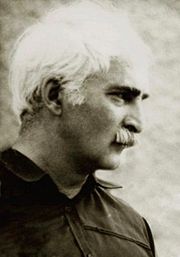
On April 9, 1991, shortly before the collapse of the USSR, Georgia declared independence. On May 26, 1991, Zviad Gamsakhurdia was elected as a first President of independent Georgia. However, he was soon deposed in a bloody coup d'état, from December 22, 1991 to January 6, 1992. The coup was instigated by part of the National Guards and a paramilitary organization called "Mkhedrioni". The country became embroiled in a bitter civil war which lasted almost until 1995. Eduard Shevardnadze returned to Georgia in 1992 and joined the leaders of the coup — Kitovani and Ioseliani — to head a triumvirate called the "State Council".
In 1995, Shevardnadze was officially elected as a president of Georgia. At the same time, two regions of Georgia, Abkhazia and South Ossetia, quickly became embroiled in disputes with local separatists that led to widespread inter-ethnic violence and wars. Supported by Russia, Abkhazia and South Ossetia achieved de facto independence from Georgia. More than 250,000 Georgians were ethnically cleansed from Abkhazia by Abkhaz separatists and North Caucasians volunteers (including Chechens) in 1992-1993. More than 25,000 Georgians were expelled from Tskhinvali as well, and many Ossetian families were forced to abandon their homes in the Borjomi region and move to Russia.
The Modern period
| This article documents ongoing warfare. Information might change rapidly and initially be unconfirmed as the conflict evolves. |
In 2003, Shevardnadze (who won reelection in 2000) was deposed by the Rose Revolution, after Georgian opposition and international monitors asserted that the November 2 parliamentary elections were marred by fraud.[29] The revolution was led by Mikheil Saakashvili, Zurab Zhvania and Nino Burjanadze, former members and leaders of Shavarnadze's ruling party. Mikheil Saakashvili was elected as President of Georgia in 2004.
Following the Rose Revolution, a series of reforms was launched to strengthen the country's military and economic capabilities. The new government's efforts to reassert the Georgian authority in the southwestern autonomous republic of Ajaria led to a major crisis early in 2004. Success in Ajaria encouraged Saakashvili to intensify his efforts, but without success, in the breakaway South Ossetia. These events resulted in a severe deterioration of relations with Russia, fueled also by Russia's open assistance and support to the two secessionists areas. Russian military bases (dating back to Soviet era) in Georgia were evacuated, with the last remaining base in Batumi handed over to Georgia in 2007.[30]
On August 7, 2008 Georgian forces entered South Ossetia, which is situated on the border with Russia, in an attempt to bring the region under government control. On August 8, while the world media was almost entirely focused on the opening ceremony of the 2008 Summer Olympics in Beijing, Russian military forces retaliated by entering South Ossetia and allegedly launching a series of airstrikes against Georgian forces (and, according to Georgian president Mikheil Saakashvili, civilian targets outside of the actual conflict zone).[verification needed] Russia has denied doing this.[verification needed] Due to the intensive war activity in South Ossetia there are controversial reports about the possible casualties on both sides, targets which have fallen under aerial attacks, troop movements and the current front line between the Georgian and Russian-Ossetian combat groupings.[31]
Geography and climate

In the north, Georgia has a 723 km common border with Russia, specifically with the Northern Caucasus federal district. The following Russian republics/subdivisions — from west to east — border Georgia: Krasnodar Krai, Karachay-Cherkessia, Kabardino-Balkaria, North Ossetia-Alania, Ingushetia, Chechnya, Dagestan. Georgia also shares borders with Azerbaijan (322 km) to the south-east, Armenia (164 km.) to the south, and Turkey (252 km.) to the south-west.
Mountains are the dominant geographic feature of Georgia. The Likhi Range divides the country into eastern and western halves. Historically, the western portion of Georgia was known as Colchis while the eastern plateau was called Iberia. Due to a complex geographic setting, mountains also isolate the northern region of Svaneti from the rest of Georgia.
The Greater Caucasus Mountain Range separates Georgia from the North Caucasian Republics of Russia. The main roads through the mountain range into Russian territory lead through the Roki Tunnel between South and North Ossetia and the Darial Gorge (in the Georgian region of Khevi). The Roki Tunnel is vital for the Russian military in the ongoing 2008 South Ossetia War.
The southern portion of the country is bounded by the Lesser Caucasus Mountains. The Greater Caucasus Mountain Range is much higher in elevation than the Lesser Caucasus Mountains, with the highest peaks rising more than 5,000 meters (16,400 ft) above sea level.
The highest mountain in Georgia is Mount Shkhara at 5,201 meters (17,059 ft), and the second highest is Mount Janga (Jangi-Tau) at 5,051 meters (16,572 ft) above sea level. Other prominent peaks include Kazbegi (Kazbek) at 5,047 meters (16,554 ft), Tetnuldi (4,974 m./16,319ft.), Shota Rustaveli (4,960 m./16,273ft.), Mt. Ushba (4,710 m./15,453ft.), and Ailama (4,525 m./14,842ft.). Out of the abovementioned peaks, only Kazbegi is of volcanic origin. The region between Kazbegi and Shkhara (a distance of about 200 km. along the Main Caucasus Range) is dominated by numerous glaciers. Out of the 2,100 glaciers that exist in the Caucasus today, approximately 30% are located within Georgia.
The term, Lesser Caucasus Mountains is often used to describe the mountainous (highland) areas of southern Georgia that are connected to the Greater Caucasus Mountain Range by the Likhi Range. The area can be split into two separate sub-regions; the Lesser Caucasus Mountains, which run parallel to the Greater Caucasus Range, and the Southern Georgia Volcanic Highland, which lies immediately to the south of the Lesser Caucasus Mountains. The overall region can be characterized as being made up of various, interconnected mountain ranges (largely of volcanic origin) and plateaus that do not exceed 3,400 meters (approximately 11,000 ft) in elevation. Prominent features of the area include the Javakheti Volcanic Plateau, lakes, including Tabatskuri and Paravani, as well as mineral water and hot springs. The Southern Georgia Volcanic Highland is a young and unstable geologic region with high seismic activity and has experienced some of the most significant earthquakes that have been recorded in Georgia.
The Voronya Cave (aka Krubera-Voronia Cave) is the deepest known cave in the world. It is located in the Arabika Massif of the Gagra Range, in Abkhazia, Georgia, Caucasus. The height difference in the cave is 2,140 (± 9) metres. The same cave set the previous record for depth at 1,710 metres in 2001 by a Russian–Ukrainian team. In 2004 the penetrated depth was increased on each of three expeditions. At that point the Ukrainian team crossed the –2000 m mark for the first time in the history of speleology. In October 2005, a new, unexplored part was found by CAVEX team, and the cave became even deeper. This expedition confirmed the depth of the cave which is now – 2,140 (± 9) metres deep.
Two major rivers in Georgia are the Rioni and the Mtkvari.
- See also: Glaciers of Georgia
Topography
The landscape within the nation's boundaries is quite varied. Western Georgia's landscape ranges from low-land marsh-forests, cow swamps, and temperate rain forests to eternal snows and glaciers, while the eastern part of the country even contains a small segment of semi-arid plains characteristic of Central Asia. Forests cover around 40% of Georgia's territory while the alpine/subalpine zone accounts for roughly around 10% of the land.
Much of the natural habitat in the low-lying areas of Western Georgia has disappeared over the last 100 years due to the agricultural development of the land and urbanization. The large majority of the forests that covered the Colchis plain are now virtually non-existent with the exception of the regions that are included in the national parks and reserves (i.e. Paleostomi Lake area). At present, the forest cover generally remains outside of the low-lying areas and is mainly located along the foothills and the mountains. Western Georgia's forests consist mainly of deciduous trees below 600 meters (1,968 ft) above sea level and comprise of species such as oak, hornbeam, beech, elm, ash, and chestnut. Evergreen species such as box may also be found in many areas. Ca. 1000 of all 4000 higher plants of Georgia are endemic in this country[32]. The west-central slopes of the Meskheti Range in Ajaria as well as several locations in Samegrelo and Abkhazia are covered by temperate rain forests. Between 600–1,500 meters (1,968-4,920 ft) above sea level, the deciduous forest becomes mixed with both broad-leaf and coniferous species making up the plant life. The zone is made up mainly of beech, spruce, and fir forests. From 1,500-1,800 meters (4,920-5,904 ft), the forest becomes largely coniferous. The tree line generally ends at around 1,800 meters (5,904 ft) and the alpine zone takes over, which in most areas, extends up to an elevation of 3,000 meters (9,840 ft) above sea level. The eternal snow and glacier zone lies above the 3,000 meter line.
Eastern Georgia's landscape (referring to the territory east of the Likhi Range) is considerably different from that of the west. Although, much like the Colchis plain in the west, nearly all of the low-lying areas of eastern Georgia including the Mtkvari and Alazani River plains have been deforested for agricultural purposes. In addition, due to the region's relatively drier climate, some of the low-lying plains (especially in Kartli and south-eastern Kakheti) were never covered by forests in the first place. The general landscape of eastern Georgia comprises numerous valleys and gorges that are separated by mountains. In contrast with western Georgia, nearly 85% of the forests of the region are deciduous. Coniferous forests only dominate in the Borjomi Gorge and in the extreme western areas. Out of the deciduous species of trees, beech, oak, and hornbeam dominate. Other deciduous species include several varieties of maple, aspen, ash, and hazelnut. The Upper Alazani River Valley contains yew forests. At higher elevations above 1,000 meters (3,280 ft) above sea level (particularly in the Tusheti, Khevsureti, and Khevi regions), pine and birch forests dominate. In general, the forests in eastern Georgia occur between 500–2,000 metres (1,640–6,560 ft) above sea level, with the alpine zone extending from 2,000/2,200–3,000/3,500 metres (roughly about 6,560–11,480 ft). The only remaining large, low-land forests remain in the Alazani Valley of Kakheti. The eternal snow and glacier zone lies above the 3,500 metre (11,480 ft) line in most areas of eastern Georgia.
Fauna
Due to its high landscape diversity and low latitude Georgia is home to a higher number of animal species, e. g. ca. 1000 species of vertebrates (330 birds, 160 fish, 48 reptiles, 11 amphibians). A number of large carnivores live in the forests, e. g. Persian leopard, Brown bear, wolf, and lynx. The species number of invertebrates is considered to be very high but data is distributed across a high number of publications. The spider checklist of Georgia, for example, includes 501 species[33].
Climate
The climate of Georgia is extremely diverse, considering the nation's small size. There are two main climatic zones, roughly separating Eastern and Western parts of the country. The Greater Caucasus Mountain Range plays an important role in moderating Georgia's climate and protects the nation from the penetration of colder air masses from the north. The Lesser Caucasus Mountains partially protect the region from the influence of dry and hot air masses from the south as well.
Much of western Georgia lies within the northern periphery of the humid subtropical zone with annual precipitation ranging from 1000–4000 mm. (39–157 inches). The precipitation tends to be uniformly distributed throughout the year, although the rainfall can be particularly heavy during the Autumn months. The climate of the region varies significantly with elevation and while much of the lowland areas of western Georgia are relatively warm throughout the year, the foothills and mountainous areas (including both the Greater and Lesser Caucasus Mountains) experience cool, wet summers and snowy winters (snow cover often exceeds 2 meters in many regions). Ajaria is the wettest region of the Caucasus, where the Mt. Mtirala rainforest, east of Kobuleti receives around 4500 mm (177 inches) of precipitation per year.
Eastern Georgia has a transitional climate from humid subtropical to continental. The region's weather patterns are influenced both by dry, Central Asian/Caspian air masses from the east and humid, Black Sea air masses from the west. The penetration of humid air masses from the Black Sea is often blocked by several mountain ranges (Likhi and Meskheti) that separate the eastern and western parts of the nation. Annual precipitation is considerably less than that of western Georgia and ranges from 400–1600 mm (16–63 inches). The wettest periods generally occur during Spring and Autumn while Winter and the Summer months tend to be the driest. Much of eastern Georgia experiences hot summers (especially in the low-lying areas) and relatively cold winters. As in the western parts of the nation, elevation plays an important role in eastern Georgia as well, and climatic conditions above 1500 metres (4920ft) above sea level are considerably cooler (even colder) than those of the low-lying areas. The regions that lie above 2000 meters (6560ft) above sea level frequently experience frost even during the summer months.
Regions
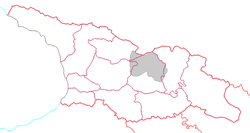
Georgia is divided into nine regions. The nine regions are Guria, Imereti, Kakheti, Kvemo Kartli, Mtskheta-Mtianeti, Racha-Lechkhumi and Kvemo Svaneti, Samegrelo-Zemo Svaneti, Samtskhe-Javakheti, and Shida Kartli.
Districts and cities
Georgia is divided into 69 districts. The following are districts in Georgia: Abasha, Adigeni, Akhalgori, Akhalkalaki, Akhaltsikhe, Akhmeta, Ambrolauri, Aspindza, Baghdati, Batumi, Bolnisi, Borjomi, Chiatura, Chkhorotsku, Chokhatauri, Dedoplistskaro, Dmanisi, Dusheti, Gagra, Gali, Gardabani, Gori, Gudauta, Gulripshi, Gurjaani, Java, Kareli, Kaspi, Kedi, Kharagauli, Khashuri, Khelvachauri, Khobi, Khoni, Khulo, Kobuleti, Kutaisi, Kvareli, Lagodekhi, Lanchkhuti, Lentekhi, Marneuli, Martvili, Mestia, Mtskheta, Ninotsminda, Oni, Ozurgeti, Poti, Rustavi, Sachkhere, Sagarejo, Samtredia, Senaki, Shuakhevi, Sighnaghi, Sukhumi, Stepantsminda, Telavi, Terjola, Tetritskaro, Tianeti, Tkibuli, Tsageri, Tskhinvali, Tsalenjikha, Tsalka, Tskaltubo, Vani, Zestaponi, and Zugdidi.
The largest city is Tbilisi. The main cities of Georgia are:
Other major cities include Chiatura, Gagra, Gori, Poti, Rustavi, Sukhumi, Tkibuli, Tskaltubo, and Tskhinvali.
Autonomous republics
Currently, the status of South Ossetia, a former autonomous administrative district (also known as the Tskhinvali region), is being negotiated with the Russian-supported separatist government. Recently these negotiations have broken down in light of Russia's decision to reinforce the region militarily and give Russian passports to South Ossetians. The government of Georgia has expressed that it views these moves as attempts by Russia to annex the region effectively. The Georgian government levels the same criticism against Russian involvement in Abkhazia, another breakaway region; Abkhazia has the status of an autonomous republic, but operates as a de facto state. This condition follows the ethnic cleansing of at least 200,000 Georgians in the War in Abkhazia in 1992-1993. Upper Kodori Gorge is the only part of Abkhazia that remains under effective Georgian control. Ajaria gained autonomy unilaterally under local strongman Aslan Abashidze with help from a Russian military brigade located on a base in Ajaria. Current Georgian president Mikheil Saakashvili restored the region to Georgian control after a local uprising against Abashidze's perceived corruption.
Government and politics
Following a crisis involving allegations of ballot fraud in the 2003 parliamentary elections, Eduard Shevardnadze resigned as president on November 23, 2003, in the bloodless Rose Revolution. The interim president was the speaker of the outgoing parliament (whose replacement was annulled), Nino Burjanadze. On January 4, 2004 Mikheil Saakashvili, leader of the United National Movement won the country's presidential election and was inaugurated on January 25.
Fresh parliamentary elections were held on March 28, 2004, where the United National Movement's parliamentary faction, the NMD, secured the vast majority of the seats (with ca. 75% of the votes). Only one other party reached the 7% threshold: the Rightist Opposition with ca. 7.5%. The vote is believed to have been one of the freest ever held in independent Georgia although an upsurge of tension between the central government and the Ajarian leader Aslan Abashidze affected the elections in this region. Despite recognizing progress the OSCE noted the tendency to misuse state administration resources in favor of the ruling party.[4]
Tensions between Georgia and Ajaria increased after the elections, climaxing on May 1, 2004 when Abashidze responded to military maneuvers held by Georgia near the region by having the three bridges connecting Ajaria and the rest of Georgia over the Choloki River blown up. On May 5, Abashidze was forced to flee Georgia as mass demonstrations in Batumi called for his resignation and Russia increased their pressure by deploying Security Council secretary Igor Ivanov.
On February 3, 2005, Prime Minister Zurab Zhvania allegedly died of carbon monoxide poisoning in an apparent gas leak at the home of Raul Usupov, deputy governor of Kvemo Kartli region. Later, Zhvania's close friend and a long-time ally, Finance Minister Zurab Nogaideli was appointed for the post by President Saakashvili.
Since coming to power in 2004, Saakashvili has boosted spending on the country's armed forces and increased its overall size to around 45,000. Of that figure, 12,000 have been trained in advanced techniques by U.S. military instructors.[34] Some of these troops have been stationed in Iraq as part of the international coalition in the region, serving in Baqubah and the Green Zone of Baghdad. In May 2005, the 13th "Shavnabada" Light Infantry Battalion became the first full battalion to serve outside of Georgia. This unit was responsible for two checkpoints to the Green Zone, and provided security for the Iraqi Parliament. In October 2005, the unit was replaced by the 21st Infantry Battalion. Soldiers of the 13th "Shavnabada" Light Infantry Battalion wear the "combat patches" of the American unit they served under, the Third Infantry Division.
The Georgian government claims to have restored "constitutional order" in the Upper Kodori Gorge - The sole Georgia-controlled part of breakaway region Abkhazia.[35]
Georgia has in the past few years significantly reduced corruption. Transparency International ranked Georgia at 79th in the world in its 2007 Corruption Perceptions Index, giving it a score of 2.8 (with number 10 being considered the best possible score).[36] This is a significant improvement on Georgia's 2005 and 2006 Corruption Perceptions Index, where it was rated joint 130th and joint 99th, respectively. On November 7, 2007, during a period of mass protests, President Saakashvili declared Tbilisi to be in a state of emergency. There had been massive demonstrations and protests by the civil opposition. The opposition has been demanding the resignation of President Saakashvili. The Georgian police used teargas, batons, water cannons and high tech acoustic weapons to clear the streets of Tbilisi. Later the same day, the President declared a state of emergency in the whole country of Georgia lasting for 15 days. The Russian government denies accusations of being involved or of interfering in the situation. President Saakashvili rejected all demands that he resign his position, but announced early presidential elections to be held in January 2008, effectively cutting his term in office by a year.
On November 16, 2007, Prime Minister of Georgia Zurab Noghaideli announced his resignation due to poor health conditions. Noghaideli underwent heart operation in April 2007 at St. Luke's Episcopal Hospital in Houston, USA which was led by the leading US surgeon Dr. Charles Frazier.
President Saakashvili invited Vladimer Gurgenidze, MBA holder from Emory University, USA and former business executive, to succeed Noghaideli on the position of the PM on the same day. Lado Gurgenidze was formally approved on the position and granted the trust of the Parliament of Georgia on 22 November 2007. Gurgenidze implemented only two changes in the Cabinet of Georgia so far, replacing Alexandre Lomaia, the former Minister for Education and Science and new Secretary of National Security Council with Maia Miminoshvili, former Head of the National Assessment and Examination Centre (NAEC). Prime Minister also invited Koba Subeliani, former Head of Municipal Accomplishment Service to succeed Giorgi Kheviashvili, former Minister for Refugees and Accommodation. New Prime Minister and two Ministers Koba Subeliani and Maia Miminoshvili were approved on their positions on 22 November 2007 by a confidence vote of the Parliament of Georgia.
Mikheil Saakashvili resigned from the position of the President on 25 November 2007 as the Constitution of Georgia requires the president stands down at least 45 days before the next election in order to be eligible for retaking part him/herself. The Speaker of the Parliament of Georgia Mrs. Nino Burjanadze took over the position until the results were announced on 5 January 2008.
The registration for presidential elections was officially closed on 27 November. 22 people, including the most recent president Mikheil Saakashvili, approved candidate of the united opposition Levan Gachechiladze, influential businessman Badri Patarkatsishvili, Leader of the New Right Party David Gamkrelidze, the Leader of the Georgian Labour Party Shalva Natelashvili, the Leader of Hope Party Irina Sarishvili-Chanturia and Giorgi Maisashvili put forward themselves for forthcoming elections.
On 27 November it was announced that a NATO membership referendum and election date referendum will also be held on the election day together with presidential elections. [5] The November 7th elections determined that more than 77% of the population voted in favor to NATO membership.
The presidential election votes came back with Mikheil Saakashvili winning with 1,060,042 votes, 53.47% of the vote, over double the amount of his nearest rival Levan Gachechiladze, coming second with 25.69%.
Mikhail Saakashvili on May 22, 2008 announced his confident victory for his ruling party in parliamentary polls amid fears of political unrest, and rising tensions between Georgia and Russia. Early official results indicated his United National Movement had 63% of the votes against the opposition's 13%, with about a quarter of the 3,664 precincts.[37]
Foreign relations
Georgia maintains good relations with its direct neighbours Armenia, Azerbaijan and Turkey and participates actively in regional organizations, such as the Black Sea Economic Council and the GUAM.[38] Georgia also maintains close political, economic and military relations with Ukraine.
The growing US and European Union influence in Georgia, notably through the Train and Equip military assistance programme and the construction of the Baku-Tbilisi-Ceyhan pipeline, have frequently strained Tbilisi’s relations with Moscow.
Georgia has been recently invaded by Russian armed forces due to the conflict over Ossetia. Georgia is currently working to become a full member of NATO. In August 2004, the Individual Partnership Action Plan of Georgia was submitted officially to NATO. On October 29, 2004, the North Atlantic Council of NATO approved the Individual Partnership Action Plan (IPAP) of Georgia and Georgia moved on to the second stage of Euro-Atlantic Integration. In 2005, by the decision of the President of Georgia, a state commission was set up to implement the Individual Partnership Action Plan, which presents an interdepartmental group headed by the Prime Minister. The Commission was tasked with coordinating and controlling the implementation of the Individual Partnership Action Plan. On February 14, 2005, the agreement on the appointment of Partnership for Peace (PfP) liaison officer between Georgia and the North Atlantic Treaty Organization came into force, whereby a liaison officer for the South Caucasus was assigned to Georgia. On March 2, 2005, the agreement was signed on the provision of the host nation support to and transit of NATO forces and NATO personnel. On March 6-9, 2006, the IPAP implementation interim assessment team arrived in Tbilisi. On April 13, 2006, the discussion of the assessment report on implementation of the Individual Partnership Action Plan was held at NATO Headquarters, within 26+1 format.[39] In 2006, the Georgian parliament voted unanimously for the bill which calls for integration of Georgia into NATO. The majority of Georgians and politicians in Georgia support the push for NATO membership. Currently, it is expected that Georgia will join NATO in 2009.

George W. Bush became the first sitting U.S. president to visit the country.[40] The street leading to Tbilisi International Airport has since been dubbed George W. Bush Avenue.[41]
From the European commission website: President Saakashvili views membership of the EU and NATO as a long term priority. As he does not want Georgia to become an arena of Russia-US confrontation he seeks to maintain close relations with the United States and European Union, at the same time underlining his ambitions to advance co-operation with Russia.[42]
On October 2, 2006, Georgian and the European Union signed a joint statement on the agreed text of the Georgia-European Union Action Plan within the European Neighbourhood Policy (ENP). The Action Plan was formally approved at the EU-Georgia Cooperation Council session on November 14, 2006 in Brussels.[43]
On February 2, 2007, Georgia officially became the most recent regional member of the Asian Development Bank. They currently hold 12,081 shares in the bank, 0.341 percent of the total.
Military
Georgia's military is collectively known as the Georgian Armed Forces (GAF). The mission and functions of the GAF are based on the Constitution of Georgia, Georgia’s Law on Defense and National Military Strategy, and international agreements to which Georgia is signatory. They are performed under the guidance and authority of the Ministry of Defense. The current Defence Minister is Davit Kezerashvili, and Chief of Joint Staff is Colonel Zaza Gogava.
Economy
Archaeological research demonstrates that Georgia has been involved in commerce with many lands and empires since the ancient times, largely due its location on the Black Sea and later on the historical Silk Road. Gold, silver, copper and iron have been mined in the Caucasus Mountains. Wine making is a very old tradition.
Throughout Georgia's modern history agriculture and tourism have been principal economic sectors, due to the country's climate and topography.[1]
For much of the 20th century, Georgia's economy was within the Soviet model of command economy.
Since the fall of the USSR in 1991, Georgia embarked on a major structural reform designed to transition to a free market economy. However, as with all other post-Soviet states, Georgia faced a severe economic collapse. The civil war and military conflicts in South Ossetia and Abkhazia aggravated the crisis. The agriculture and industry output diminished. By 1994 the gross domestic product had shrunk to a quarter of that of 1989.[44]
The first financial help from the West came in 1995, when the World Bank and International Monetary Fund granted Georgia a credit of USD 206 million and Germany granted DM 50 million.
As of 2001 54% of the population lived below the national poverty line but by 2006 poverty decreased to 34%. In 2005 average monthly income of a household was GEL 347 (about 200 USD).[45]
Since early 2000s visible positive developments have been observed in the economy of Georgia. In 2006 Georgia's real GDP growth rate reached 8.8%, making Georgia one of the fastest growing economies in Eastern Europe.[1] The World Bank dubbed Georgia "the number one economic reformer in the world" because it has in one year improved from rank 112th to 18th in terms of ease of doing business.[46]However, the country has high unemployment rate of 12.6% and has fairly low median income compared to European countries.
IMF 2006 estimates place Georgia's nominal GDP at US$7.76 billion. Georgia's economy is becoming more devoted to services (now representing 54.8% of GDP), moving away from agricultural sector ( 17.7%).[1]
The country has sizable hydropower resources.
The 2006 ban on imports of Georgian wine to Russia, one of Georgia's biggest trading partners, and break of financial links was described by the IMF Mission as an "external shock",[47] In addition, Russia increased the price of gas for Georgia. This was followed by the spike in the Georgian lari's rate of inflation.[citation needed] The National Bank of Georgia stated that the inflation was mainly triggered by external reasons, including Russia’s economic embargo.[48] The Georgian authorities expected that the current account deficit the embargo would cause in 2007 would be financed by "higher foreign exchange proceeds generated by the large inflow of foreign direct investment" and an increase in tourist revenues.[49] The country has also maintained a solid credit in international market securities.[50]
Georgia is becoming more integrated into the global trading network: its 2006 imports and exports account for 10% and 18% of GDP respectively.[1] Georgia's main imports are natural gas, oil products, machinery and parts, and transport equipment.
In 2004, a 12% flat income tax was introduced in Georgia.[51] Tax collection increased significantly, thereby reducing the government's formerly large budget deficits.[citation needed]
Georgia is developing into an international transport corridor through Batumi and Poti ports, an oil pipeline from Baku through Tbilisi to Ceyhan, the Baku-Tbilisi-Ceyhan pipeline (BTC) and a parallel gas pipeline, the South Caucasus Pipeline.
Tourism is an increasingly significant part of the Georgian economy. About a million tourists brought US$313 million to the country in 2006.[52] There are "over 12,000 historical and cultural monuments in Georgia, four listed by UNESCO as cultural heritage sites, 103 resorts, 182 potential resort places and more than 2000 mineral springs in Georgia".[53]
Demographics
Georgians (with Adjarians, Mingrelians, Svans, Lazs) form a majority, about 83.8%, of Georgia's current population of 4,661,473 (July 2006 est.).[54] Other major ethnic groups include Azeris, who form 6.5% of the population, Armenians - 5.7%, Russians - 1.5%, Abkhazians, and Ossetians. Numerous smaller groups also live in the country, including Assyrians, Chechens, Chinese, Georgian Jews, Greeks, Kabardins, Kurds, Tatars, Turks and Ukrainians. Notably, Georgia's Jewish community is one of the oldest Jewish communities in the world.
Georgia also exhibits significant linguistic diversity. Within the South Caucasian family, Georgian, Laz, Mingrelian, and Svan are spoken. Additionally, non-Georgian ethnic groups in the country often speak their native languages in addition to Georgian. The official languages of Georgia are Georgian and also Abkhaz within the autonomous region of Abkhazia. 71% of the population speaks the South Caucasian languages, 9% - Russian, 7% - Armenian, 6% - Azeri and 7% other.[citation needed] Georgia's literacy rate is 100%.[6]
In the early 1990s, following the dissolution of the Soviet Union, violent separatist conflicts broke out in the autonomous regions of Abkhazia and South Ossetia, which resulted in ethnic cleansing of Georgians from Abkhazia, where ethnic Georgians previously had constituted the largest single ethnic group (46% of population in 1989). Many Ossetians living in Georgia also left the country, mainly to Russia's North Ossetia.[55] Of the Meskhetian Turks who were forcibly relocated in 1944 only a tiny fraction returned to Georgia as of 2007.
Georgia's net migration rate is -4.54, excluding Georgian nationals who live abroad. Georgia has nonetheless been inhabited by immigrants from all over the world throughout its independence. According to 2006 statistics, Georgia gets most of its immigrants from Turkey and China.
Today most of the population practices Orthodox Christianity of the Georgian Orthodox Church (81.9%). The religious minorities are: Muslim (9.9%); Armenian Apostolic (3.9%); Russian Orthodox Church (2.0%); Roman Catholic (0.8%). 0.8% of those recorded in the 2002 census declared themselves to be adherents of other religions and 0.7% declared no religion at all.[1]
Culture
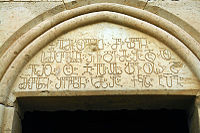
Georgian culture evolved over thousands of years with its foundations in Iberian and Colchian civilizations,[56] continuing into the rise of the unified Georgian Kingdom under the single monarchy of the Bagrationi. Georgian culture enjoyed a golden age and renaissance of classical literature, arts, philosophy, architecture and science in the 11th century.[57] The Georgian language, and the Classical Georgian literature of the poet Shota Rustaveli, were revived in the 19th century after a long period of turmoil, laying the foundations of the romantics and novelists of the modern era such as Grigol Orbeliani, Nikoloz Baratashvili, Ilia Chavchavadze, Akaki Tsereteli, Vazha Pshavela, and many others.[58] Georgian culture was influenced by Classical Greece, the Roman Empire and the Byzantine Empire, and later by the Russian Empire which contributed to the European elements of Georgian culture.

Georgia is well known for its rich folklore, unique traditional music, theatre, cinema, and art. Georgians are renowned for their love of music, dance, theatre and cinema. In the 20th century there have been notable Georgian painters such as Niko Pirosmani, Lado Gudiashvili, Elene Akhvlediani; ballet choreographers such as George Balanchine, Vakhtang Chabukiani, and Nino Ananiashvili; poets such as Galaktion Tabidze, Lado Asatiani, and Mukhran Machavariani; and theatre and film directors such as Robert Sturua, Tengiz Abuladze, Giorgi Danelia and Otar Ioseliani.[59]
Architecture and arts
Georgian architecture has been influenced by many civilizations. There are several different architectural styles for castles, towers, fortifications and churches. The Upper Svaneti fortifications, and the castle town of Shatili in Khevsureti, are some of the finest examples of medieval Georgian castle architecture.
Georgian ecclesiastic art is one of the most fascinating aspects of Georgian Christian architecture, which combines classical dome style with original basilica style forming what is known as the Georgian cross-dome style. Cross-dome architecture developed in Georgia during the 9th century; before that, most Georgian churches were basilicas. Georgian culture strongly emphasizes individualism, and this is expressed through the allocation of interior space in Georgian churches. Other examples of Georgian ecclesiastic architecture can be found outside Georgia: Bachkovo Monastery in Bulgaria (built in 1083 by the Georgian military commander Grigorii Bakuriani), Iviron monastery in Greece (built by Georgians in the 10th century), and the Monastery of the Cross in Jerusalem (built by Georgians in the 9th century).
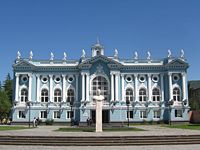
Other architectural aspects of Georgia include Rustaveli avenue in Tbilisi in the Hausmann style, and the Old Town District.
The art of Georgia spans the prehistoric, the ancient Greek, Roman, medieval, ecclesiastic, iconic and modern visual arts. One of the most famous late nineteenth/early twentieth century Georgian artists is the primitivist painter Niko Pirosmani. Pirosmani's works can also been seen as early impressionistic, due to the fact that his work inspired Lado Gudiashvili and Elene Akhvlediani, who represent the more mainstream impressionism of the twentieth century.
Society
Cuisine
Georgian cuisine and wine have evolved through the centuries, adapting traditions in each era. One of the most unusual traditions of dining is Supra, or Georgian table, which is also a way of socializing with friends and extended family. The head of Supra is known as Tamada. He also conducts the highly philosophical toasts, and makes sure that everyone is enjoying themselves. Various historical regions of Georgia are known for their particular dishes: for example, Khinkali (meat dumplings), from eastern mountainous Georgia, and Khachapuri, mainly from Imereti, Samegrelo and Adjara.
In addition to traditional Georgian dishes, the foods of other countries have been brought to Georgia by immigrants from Russia, Greece, and recently China.
Education
Religion
According to the Constitution of Georgia, religious institutions are separate from government and every citizen has the right of religion. However, most of the population of Georgia (82%) practices Orthodox Christianity and Georgian Orthodox Church is an influential institution in the country.
The Gospel was preached in Georgia by the Apostles, Andrew the First Called, Simon the Canaanite, and Matthias. Iberia was officially converted to Christianity in 326 [61] by Saint Nino of Cappadocia, who is considered to be the Enlightener of Georgia and the Equal to Apostles by the Orthodox Church. The Georgian Orthodox Church, once being under the See of Antioch, gained an autocephalous status in the 4th century during the reign of King Vakhtang Gorgasali.[62]
Religious minorities of Georgia include Russian Orthodox (2%), Armenian Christians (3.9%), Muslims (9.9%), Roman Catholics (0.8%), as well as sizeable Jewish Communities and various Protestant minorities.[63]
Despite the long history of religious harmony in Georgia,[64] there have been several instances of religious discrimination in the past decade, such as the Vasil Mkalavishvili Case.[65]
Sports
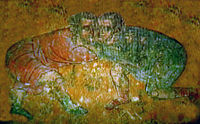
Among the most popular sports in Georgia are football, basketball, rugby union, wrestling, hockey and weightlifting. Historically, Georgia has been famous for its physical education; it is known that the Romans were fascinated with Georgians' physical qualities after seeing the training techniques of ancient Iberia.[66] Wrestling remains a historically important sport of Georgia, and some historians think that the Greco-Roman style of wrestling incorporates many Georgian elements.[67] Within Georgia, one of the most popularized styles of wrestling is the Kakhetian style. However, there were a number of other styles in the past that are not as widely used today. For example, the Khevsureti region of Georgia has three different styles of wrestling. Other popular sports in 19th century Georgia were polo, and lelo, a traditional Georgian game later replaced by rugby union.
See also
Gallery of Georgia
|
Gremi Kakheti |
Notes
- ^ a b c d e f Georgia, from CIA World Factbook
- ^ CIA Factbook: Republic of Gerogia, (English)
- ^ Department of Statistics under Ministry of Economic Development of Georgia. Statistical Yearbook of Georgia: 2007, p. 22. Tbilisi, 2008.
- ^ Parsons, Robert (2008-01-11), "Mikheil Saakashvili’s bitter victory", openDemocracy.net. Retrieved on 2008-05-21.
- ^ Cutler, David & Balmforth, Richard (2008-05-21), "Timeline – Events leading to Georgia's election", Thomson Reuters. Retrieved on 2008-05-21.
- ^ Foreign Policy Strategy 2006-2009, pp. 9-10. Ministry of Foreign Affairs of Georgia. Retrieved on 2006-06-27.
- ^ Rapp (2003), pp. 420, 429-430.
- ^ Braund, David. Georgia in Antiquity: A History of Colchis and Transcaucasian Iberia, 550 BC-AD 562, pp. 17-18
- ^ Wilson, Nigel Guy (2006). Encyclopedia of Ancient Greece. Routledge, 320. ISBN 0415973341.
- ^ A New Theory on the Etymology of the Designations of the Georgians
- ^ Hibbert, Christopher. The House of Medici: Its Rise and Fall.
- ^ David Marshall Lang, The Georgians, (New York: Frederick A. Praeger, Inc., 1966), 17-18.
- ^ St. Nino And The Conversion Of Georgia
- ^ Article 3.1 of the Constitution of Georgia
- ^ Phoenix: The Peoples of the Hills: Ancient Ararat and Caucasus by Charles Burney , David Marshall Lang, Phoenix Press; New Ed edition (December 31, 2001)
- ^ Phoenix: The Peoples of the Hills: Ancient Ararat and Caucasus by Charles Burney, David Marshall Lang, Phoenix Press; New Ed edition (December 31, 2001)
- ^ Lives and Legends of the Georgian Saints, St Vladimirs Seminary Pr; N.e.of 2r.e. edition (March 1997) by David Marshall Lang
- ^ Sketches of Georgian Church History by Theodore Edward Dowling
- ^ a b c d e "Christianity and the Georgian Empire" (early history) Library of Congress, March 1994, webpage: LCweb2-ge0015.
- ^ Gvosdev (2000), p. 85
- ^ Avalov (1906), p. 186
- ^ Gvosdev (2000), p. 86
- ^ Lang (1957), p. 249
- ^ Lang (1957), p. 251
- ^ Lang (1957), p. 247
- ^ Lang (1957), p. 252
- ^ Anchabadze (2005), p. 29
- ^ Socialism in Georgian Colors: The European Road to Social Democracy, 1883-1917 by Stephen F. Jones
- ^ EurasiaNet Eurasia Insight - Georgia’s Rose Revolution: Momentum and Consolidation
- ^ Russia Hands Over Batumi Military Base to Georgia. Civil Georgia, Tbilisi. 2007-11-13.
- ^ Russia sends forces into Georgian rebel conflict. Reuters. 2008-08-08.
- ^ Endemic Species of the Caucasus
- ^ Caucasian Spiders » CHECKLISTS & MAPS
- ^ * http://www.kyivpost.com/bn/24927/ - "Georgian president proposes military reserve system for defense, disaster response"
- ^ Tbilisi prepares to send Abkhaz government-in-exile to Kodori, Zaal Anjaparidze
- ^ Corruption Perceptions Index 2007. Transparency International. Accessed on September 27, 2007
- ^ news.bbc.co.uk, Georgian leader set for poll win
- ^ redirect
- ^ Georgia's way to NATO
- ^ BBC NEWS | Europe | Bush praises Georgian democracy
- ^ Bush Heads to Europe for G - 8 Summit, The New York Times
- ^ redirect
- ^ EU, Georgia Sign ENP Action Plan, Civil Georgia, October 2, 2006.
- ^ The EBDR country factsheet - [1].
- ^ The World Bank's Economic Development and Poverty Reduction Program progress report - [2].
- ^ World Bank Economy Rankings.
- ^ IMF Mission Press Statement at the Conclusion of a Staff Visit to Georgia. June 1, 2007.
- ^ Central Bank Chief Reports on Inflation. Civil Georgia, Tbilisi. 2007-05-10.
- ^ Statement by IMF Staff Mission to Georgia, Press Release No. 06/276. December 15, 2006.
- ^ Sweet Georgia. The Financial Times - [3]
- ^ The Financial Times - Flat taxes could be a flash in the pan, IMF research says
- ^ UNTWO (June 2007). "UNTWO World Tourism Barometer, Vol.5 No.2" (PDF). Retrieved on 2008-03-26.
- ^ Invest in Georgia
- ^ This figure includes the territories currently out of the Georgian government's control – Abkhazia and South Ossetia – whose total population, as of 2005, is estimated by the State Department of Statistics of Georgia at 227,200 (178,000 in Abkhazia plus 49,200 in South Ossetia). Statistical Yearbook of Georgia, 2005: Population (607kb, Microsoft Word Document).
- ^ Human Rights Watch/Helsinki, RUSSIA. THE INGUSH-OSSETIAN CONFLICT IN THE PRIGORODNYI REGION, May 1996.
- ^ Georgia : in the mountains of poetry 3rd rev. ed., Nasmyth, Peter
- ^ Studies in medieval Georgian historiography: early texts and European contexts, Rapp, Stephen
- ^ Lang David, Georgians
- ^ Lang David, Georgians
- ^ The Early Church, Henry Chadwick, p. 34
- ^ Riassophore, Adrian monk. "A brief history of Orthodox Christian Georgia." Orthodox Word, 2006: p. 11.
- ^ Riassophore, Adrian monk. "A brief history of Orthodox Christian Georgia." Orthodox Word, 2006: p. 11.
- ^ CIA - The World Factbook - Georgia
- ^ Spilling, Michael. Georgia (Cultures of the world). 1997
- ^ Memorandum to the U.S. Government on Religious Violence in the Republic of Georgia (Human Rights Watch August 2001)
- ^ Romans erected the statue of the Iberian King Pharsman after he demonstrated Georgian training methods during his visit to Rome; Cassius Dio, Roman History, LXIX, 15.3
- ^ Williams, Douglas. Georgia in my Heart, 1999.
References
- Anchabadze, George: History of Georgia: A Short Sketch, Tbilisi 2005 ISBN 99928-71-59-8
- Avalov, Zurab: Prisoedinenie Gruzii k Rossii, Montvid, S.-Peterburg 1906
- Gvosdev, Nikolas K.: Imperial policies and perspectives towards Georgia: 1760-1819, Macmillan, Basingstoke 2000, ISBN 0-312-22990-9
- Lang, David M.: The last years of the Georgian Monarchy: 1658-1832, Columbia University Press, New York 1957
- Suny, Ronald Grigor: The Making of the Georgian Nation, (2nd Edition), Bloomington and Indianapolis, 1994, ISBN 0-253-35579-6
- Rapp, Stephen H. (2003), Studies In Medieval Georgian Historiography: Early Texts And Eurasian Contexts. Peeters Publishers, ISBN 90-429-1318-5
Further reading
- Bradt Guide: Georgia Tim Burford
- Claws of the Crab: Georgia and Armenia in Crisis Stephen Brook
- Enough!: The Rose Revolution in the Republic of Georgia 2003 Zurab Karumidze and James V. Wertshtor
- Georgia: A Sovereign Country in the Caucasus Roger Rosen
- Georgia in Antiquity: A History of Colchis and Transcaucasian Iberia 550 BC–AD 562 Braund, David, 1994. Clarendon Press, Oxford. ISBN 0-19-814473-3
- Georgia: In the Mountains of Poetry Peter Nasmyth
- Please Don't Call It Soviet Georgia: A Journey Through a Troubled Paradise Mary Russell
- The Georgian Feast: The Vibrant Culture and Savory Food of the Republic of Georgia Darra Goldstein
- Lonely Planet World Guide: Georgia, Armenia and Azerbaijan\
- Organized Crime and Corruption in Georgia Louise Shelley, Erik Scott, Anthony Latta, eds. Routledge: Oxford.
- Stories I Stole Wendell Steavenson
External links
| Find more about Georgia (country) on Wikipedia's sister projects: | |
|---|---|
| Dictionary definitions | |
| Textbooks | |
| Quotations | |
| Source texts | |
| Images and media | |
| News stories | |
| Learning resources | |
- President of Georgia
- Government of Georgia
- Ministry of Foreign Affairs of Georgia
- Department of Tourism and Resorts
- American Friends of Georgia
- Georgian Incoming Tour Operators’ Association
- Wikimedia Atlas of Georgia
- Georgia (country) travel guide from Wikitravel
- Wikia has a wiki on this subject: Georgia
- Georgia entry at The World Factbook
- Georgia (country) at the Open Directory Project
- Full information about (country) Georgia (In English, German, Russian and Georgian)
- Georgia News in Georgian (the English mirror http://www.newsgeorgia.org went dead on August 8 2008)
- NewsGeorgia Google Translation in to English from the NewsGeorgia (Russian Language) site
- Georgia TVNews
| [hide]
|
||||||||||
|---|---|---|---|---|---|---|---|---|---|---|
|
||||||||||
| [hide]
|
|
|---|---|
| [hide]
|
||||||||||||||||||||||||||||||
|---|---|---|---|---|---|---|---|---|---|---|---|---|---|---|---|---|---|---|---|---|---|---|---|---|---|---|---|---|---|---|
|
||||||||||||||||||||||||||||||





